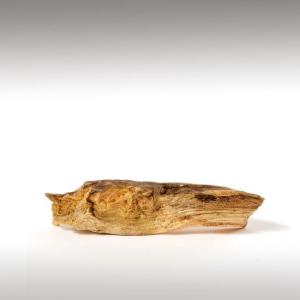
PALO SANTO ESSENTIAL OIL (BURSERA GRAVEOLENS) - ESSENTIAL OILS

BASE / GENERAL DATA
Information submited: March 24, 2015 Modified: March 21, 2018 By: OperaDreamhouse
Botanical Name: Bursera graveolens
Common Method of Extraction: Steam distilled
Part Typically Used: Dead heartwood
Color: Clear - Pale Yellow
Consistency: Thin
Perfumery Note: Middle
Strength of Initial Aroma: Sweet, woody, citrusy and slightly minty. Reminiscent of Frankincense.
Palo Santo is common today as a type of incense. Palo Santo Oil or “Holy Wood” is a very spiritual essential oil.
Bursera graveolens is a wild tree native from Mexico and the Yucatán Peninsula to Peru and Venezuela that inhabits the South American Gran Chaco region. It is also found in Costa Rica, El Salvador, Guatemala, Honduras, Colombia, Ecuador, Peru and on the Galapagos islands.
The tree belongs to the same family (Burseraceae) as Frankincense and Myrrh. Palo Santo (or Palosanto) is used for crafting objects and to produce burning sticks: however, production ofessential oilis attracting most of the modern interest. Chemical composition, as reflected by aroma, is variable.
The essential oil is distilled from the heartwood of the Palo Santo tree. It is fascinating that the heartwoodmust be at least two years old and be from the red wood to produce the higher quality oil. The longer the tree has been dead, the more powerful the oil (This also holds true for Frankincense essential oil).
The use of Palo Santo from Bursera Graveolens is traditional in South America, especially in Ecuador. According to the local customs, it is used against the "Mala Energía" (Bad energy).
In Ecuador it is against the law to remove or cut down Palo Santo trees as they are protected. Additionally, even taking the dead trees has limitations and must be permitted through the government. So, there are very few companies that are permitted to even touch the trees, more or less produce the essential oil.
These are protected, one thousand year old trees from which the windfall is collected from the ground and considered sacred by the indigenous peoples for many generations.
Tree grows for about 40 years and then dies. Then, it has to lay down for about 10 more years before people can process it.
The essential oil of the Palo Santo tree has many applications in aromatherapy.
Chemical structure:
Aged heartwood is rich in terpenes such as limonene and α-terpineol.
Animal studies show that d-limonene is contained in the peels of Citrus fruits such as Grapefruit, Orange and Lemon. It is a powerful antioxidant.
Common Method of Extraction: Steam distilled
Part Typically Used: Dead heartwood
Color: Clear - Pale Yellow
Consistency: Thin
Perfumery Note: Middle
Strength of Initial Aroma: Sweet, woody, citrusy and slightly minty. Reminiscent of Frankincense.
Palo Santo is common today as a type of incense. Palo Santo Oil or “Holy Wood” is a very spiritual essential oil.
Bursera graveolens is a wild tree native from Mexico and the Yucatán Peninsula to Peru and Venezuela that inhabits the South American Gran Chaco region. It is also found in Costa Rica, El Salvador, Guatemala, Honduras, Colombia, Ecuador, Peru and on the Galapagos islands.
The tree belongs to the same family (Burseraceae) as Frankincense and Myrrh. Palo Santo (or Palosanto) is used for crafting objects and to produce burning sticks: however, production ofessential oilis attracting most of the modern interest. Chemical composition, as reflected by aroma, is variable.
The essential oil is distilled from the heartwood of the Palo Santo tree. It is fascinating that the heartwoodmust be at least two years old and be from the red wood to produce the higher quality oil. The longer the tree has been dead, the more powerful the oil (This also holds true for Frankincense essential oil).
The use of Palo Santo from Bursera Graveolens is traditional in South America, especially in Ecuador. According to the local customs, it is used against the "Mala Energía" (Bad energy).
In Ecuador it is against the law to remove or cut down Palo Santo trees as they are protected. Additionally, even taking the dead trees has limitations and must be permitted through the government. So, there are very few companies that are permitted to even touch the trees, more or less produce the essential oil.
These are protected, one thousand year old trees from which the windfall is collected from the ground and considered sacred by the indigenous peoples for many generations.
Tree grows for about 40 years and then dies. Then, it has to lay down for about 10 more years before people can process it.
The essential oil of the Palo Santo tree has many applications in aromatherapy.
Chemical structure:
Aged heartwood is rich in terpenes such as limonene and α-terpineol.
Animal studies show that d-limonene is contained in the peels of Citrus fruits such as Grapefruit, Orange and Lemon. It is a powerful antioxidant.

SPIRITUAL PRACTISES DATA
Information submited: March 25, 2015 Modified: March 21, 2018 By: OperaDreamhouse
Palo Santo essential oil was used during the time of the Incas for its reputed spiritual purifying properties.
This tree inhabits the South American Gran Chaco region (Northern Argentina, Paraguay, Bolivia and the Brazilian Mato Grosso). Palo Santo is used by medicine-men and shamans at Ayahuasca ceremonies, rituals, healing and cleansing sessions. It has a surprisingly strong and sweet smell when burned, which is why palo santo is used as incense.
Palo Santo is used in South America in much the same way as White Ceremonial Sage is used in North America - to combat negative energy and to cleanse the space.
Palo Santo has been used for hundreds of years by native shamans for spiritual applications. For those that integrate essential oils within meditation, prayer or other spiritual applications, Palo Santo is an oil to pay close attention to.
It is important oil for use in Chakra applications. Opens the Third Eye and Crown Chakras.
This tree inhabits the South American Gran Chaco region (Northern Argentina, Paraguay, Bolivia and the Brazilian Mato Grosso). Palo Santo is used by medicine-men and shamans at Ayahuasca ceremonies, rituals, healing and cleansing sessions. It has a surprisingly strong and sweet smell when burned, which is why palo santo is used as incense.
Palo Santo is used in South America in much the same way as White Ceremonial Sage is used in North America - to combat negative energy and to cleanse the space.
Palo Santo has been used for hundreds of years by native shamans for spiritual applications. For those that integrate essential oils within meditation, prayer or other spiritual applications, Palo Santo is an oil to pay close attention to.
It is important oil for use in Chakra applications. Opens the Third Eye and Crown Chakras.

MEDICINE / HEALTH DATA

BEAUTY / COSMETICS DATA

FOOD / COOKING DATA
COMMENTS
No comments.


